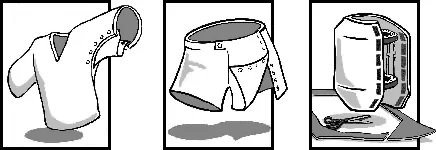Clothing Modifications & Fixator Covers

Clothing Modifications
If you will be receiving an external fixator, you will need to plan ahead and make modifications to your clothing. External fixators can make it difficult to put on clothing. Even if it is possible to force clothing to go over the fixator, most patients will find it uncomfortable. You might want to consider obtaining or making some adaptive clothing (e.g., pants with snaps up the side).
Here are some additional suggestions:
- Side-snap or tear-away nylon sports pants or shorts: These snap down the side, and some open all the way to the waist. They can be found in sporting goods stores and online.
- Sweat suits
- Bell bottoms or wide legged pants
- Inserts and modified clothing: You can split the pants leg or sleeve up the seam and then add a triangle of fabric to make the clothing wider. Another way is to use an oversized pant leg or sleeve, split the seam, and then add either Velcro or snaps (grippers are easy to apply and do not require sewing).
- Underwear: Don’t forget to adapt underwear if the apparatus will be on your leg. For women and girls, one good compromise is oversized “petti pants” because they have wide legs. “French cut,” thong, or bikini underwear might also be easier to get on because they have larger leg openings. The underwear can be split on the seam, with snaps or Velcro added for closure. Some patients have been able to find bikini underwear that unties on the sides.
- Bathing suits for the physical therapy pool: If you will receive physical therapy in a pool, you will need to modify a swimsuit. For women and girls, a two-piece suit is easier to get on and off. You might be able to find one that ties on the sides so that you don’t have to modify it.
- Shoes: Bring shoes with good traction for use during physical therapy. Depending on how your doctor places the fixator on your leg, you might be able to use low cut shoes. In some cases, a rubber sole is added to the external fixator to act as a shoe.
- Coats: If the fixator is to be applied to the arm, you will need a way to keep the arm warm during winter. A shawl or cape might be convenient.
External Fixator Covers
Although the fixator covers are primarily decorative, they also can be used to avoid stares and questions when going out in public and to keep small children’s inquisitive fingers away from the fixator and pin sites. Fixator covers are recommended if you will be in a dusty environment or around pets. They also can provide warmth during colder months.
It might be better to make the covers after surgery so that you can take accurate measurements because fixators come in a variety of shapes and sizes.
You or a seamstress might be able to create a “tube” of fabric with snaps or Velcro up the side and drawstrings or elastic at the ends. One easy way to make such a cover is to use a pillowcase, splitting it as needed, adding Velcro or snaps, and running a ribbon through the hem.
